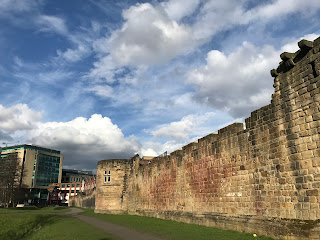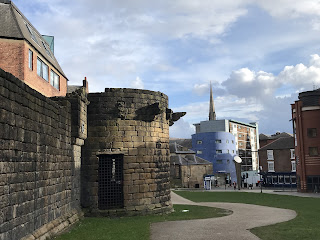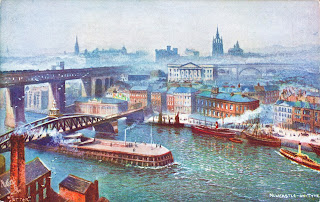I
journeyed through to Glasgow on a day with clouds so low, stiff, and grey, that
it looked almost as if the world had been wrapped in a pauper’s shroud of old. An oppressive shroud of gloom that seemed to deaden
all the colours of everything in the city.
As I left the train station, people rushed on by, heads down, and the
snarled traffic beeped and belched along the road. Heading down the busy streets I made my way across
the Clyde and into the Gorbals area of the city, where the streets seemed
almost empty. Walking past block after
block of newly built flats and houses, I ended up in an area of run down and
tired looking flats and tower blocks.
There, I found the place I was looking for, a place I’d been meaning to
have a wander around for a long time, the Southern Necropolis.
The Necropolis Gatehouse
A view down towards the
entrance to the Southern Necropolis
Gravestones and skeleton
like trees
The
Southern Necropolis, like its more famous counterpart the Glasgow Necropolis,
is a graveyard best described as a ‘city of the dead’. It was opened in 1840 and over 250,000 people
are buried there. It is the resting
place of many of the richest of Glasgow’s inhabitants as well as many of its
poorest. Though most of those interred
there are now long forgotten, there is one name that will be familiar to many
due to the product that carries his name.
That being Thomas Lipton, the man who brought the world Lipton Tea.
Thomas Lipton was a Scottish entrepreneur who was born in the Gorbals in 1848 and spent
his early life in Glasgow. After a few
years of travelling and working in the USA, he returned to Glasgow and set up a chain of
grocery stores there. By the turn of the century, he had built up a chain of over three hundred stores throughout the UK and was a very rich man. He then got
into the tea trade and conquered the American market, making himself a
multi-millionaire in the process.
Thomas
was a great self-publicist who made friends in the highest echelons of society,
including both King Edward VII and King
George V. However, he led a life of contradictions, as despite being quite a hard-nosed businessman who was also known for his flamboyant lifestyle, he was also deeply committed to philanthropy and was a vocal advocate for the welfare of working-class people. He also had a reputation as being a bit of a ladies' man, something he also tended to promote himself as, but it appears likely that he was gay. He lived for
nearly thirty years with a long-term male companion, William Love, who had been
one of his early shop assistants, and when that relationship ended, his preference was for the company of young men.
Thomas was a tireless innovator who was always looking for ways to improve his products and business practices. He was also an important figure in the development of the modern grocery store. On his death in 1931, he left most of his fortune to the city of Glasgow.
Fallen gravestone with
face of Christ
A weather worn and
crumbling Jesus
Gravestone and trees
Ivy and moss
A field of gravestones
Gravestones with a background
view of the high-rise flats at Caledonia Road
In
1954 the graveyard was the scene of a rather bizarre event. In late September of that year a rumour
spread through the local schools that a seven-foot-tall vampire had strangled
two little boys in the cemetery and then eaten them. Now, you may laugh at their gullibility in
believing this, but hark back to your own childhood and the wild rumours that
would run through the school. I remember
as a child back in the early Seventies, I was at Primary School and the rumour
went round that there was a tiger in the boys' toilet. Being five or six we all
believed it, so much so, that one of my classmates ended up pissing his pants
rather than risking going to the toilet.
When the teacher demanded to know why he hadn’t asked to go to the loo
he told her he didn’t want to be eaten by the tiger. Who told you there was a
tiger in the toilet? She demanded to
know. John - my classmate blubbered out the culprit's name. John come here; how dare you tell lies.
Whack, whack, whack. That’s pretty much
how schooling went back in Scotland in the Seventies. A few weeks later there was a rumour that our
teacher had killed one of the boys in our class for some minor misdemeanour. There’s a knife covered in blood on her desk,
one of my little chums told me and pointed to a knife on her desk with red
smears on it. When one of the girls
burst into tears and asked the teacher not to kill her, it was pointed out by
the teacher that her knife was in fact covered in strawberry jam, as she’d been
having her breakfast of toast and jam earlier that morning in the classroom. She then whacked some other unfortunate who she
suspected to have spread the story round.
Anyway,
getting back to 1954 and the rumours about the child eating vampire in the
graveyard, the kids in the Gorbals didn’t run away crying, no, they decided to
do something about it. So, hundreds of
them armed themselves with penknives, sticks and stones and descended on the
graveyard to hunt down the monster. They
searched around the gravestones, behind the trees and bushes and rushed
shouting at any shadow they saw. As the
crowds of children grew in number, concerned members of the public began to
phone the police. One of the first
officers to arrive on the scene was Constable Alex Deeprose. He arrived expecting to find some youths
causing a bit of trouble and was shocked instead to find hundreds of terrified
children who clung to him and told him about the ‘vampire with iron teeth who
just had to be killed.’ He soon felt like
the Pied Piper of Hamelin there were that many children following close to him
and crowding around him. Concerned
parents then started coming up to him and asking if there were any truth to the
rumours. He tried to reassure everyone
that there was no vampire and with the help of other officers cleared the
cemetery. However, bands of kids carried
on patrolling the streets, only heading home when it began to rain. For the next two nights, gangs of children found
their way into the graveyard to carry on the hunt for the vampire. Eventually though they tired of this and
found something else to do instead.
The
vampire was not forgotten so quickly though by those seeking an explanation to
how a tale like this could have so quickly gripped the imagination of so many
children. Some academics and politicians
quickly latched on to the American ‘horror comics’ that were popular at that time,
blamed them for ‘polluting’ the minds of the young and demanded that they be
banned. However, other academics and
social commentators pointed out that no monster matching the vampire could be
found in these comics, but rather a similar one was mentioned in the Bible, in Daniel
7:7, a ‘dreadful and terrible’ beast that ‘had great iron teeth’, and another
was mentioned in a poem taught in local schools – ‘Jenny Wi’ the Airn Teeth’
(Jenny with the iron teeth). But, at the
height of a moral panic no-one tends to listen to the voices of reason and the
call for the ban on the comics was taken up by the local MP for the Gorbals,
Alice Cullen. In 1955 legislation was
passed, banning the so called ‘horror comics’, the video nasties of their day.
On
my visit to the graveyard today I saw no signs of anyone approaching seven foot
tall and certainly no one with iron teeth.
Apart from one dog walker the place was empty, just me, the birds
singing in the trees, and the buried remains of a quarter of a million people.
Urn and gravestone
A graveyard view
Iron and stone – grave of
Isabella Wilson and numerous others
Tree exploding from old
gravestone
I
left the Skulferatu that had accompanied me on my trip, in a gap in the
patterned carving on a faded and crumbling gravestone.
A faded and crumbling
gravestone
Detail of the faded and
crumbling gravestone
Skulferatu #95
Skulferatu #95 in hollow
a in the outer pattern on the gravestone
Skulferatu #95 in hollow
a in the outer pattern on the gravestone
Map showing location of
Skulferatu #95
The
coordinates for the location of the Skulferatu are –
Latitude
55.842726
Longitude
-4.246083
what3words:
drain.tests.luxury
I
used the following sources for information on the Southern Necropolis and the
Gorbals Vampire –
Southern Necropolis, Gorbals City of the Dead
southernnecropolis.co.uk
iNews
Thomas Lipton: from a
Glasgow slum to yachting with kings
Daily Mirror – Saturday September 25th
1954
Edinburgh Evening News - Saturday 25 September
1954
Aberdeen Evening Express - Friday 1 October
1954
BBC - Child vampire hunters sparked comic
crackdown
BBC News - Scotland































































